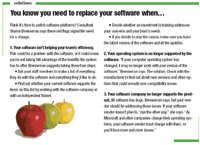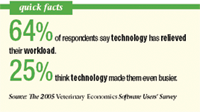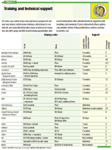Apples to apples
Look at the choices to decide which practice management software system best meets your needs—and learn what users say about their systems' best and worst features.
At its best, practice management software saves you time, enables better client compliance, and ultimately leads to more revenue and better patient care. As one respondent to The 2005 Veterinary Economics Software Users' Survey says, "It's convenient, easy to use, and cuts down on the paperwork and repetitive nature of veterinary medicine."

"Software is my least-expensive employee, and the one that complains the least," another respondent says. "It does a lot of time-consuming busywork."
And another says, "Our services are standardized by using the software. We are far less likely to leave out a necessary service."

With so many pluses, it's no wonder that nine out of every ten respondents to the survey say they use practice management software. And more than 50 percent of respondents not using software plan to install a system in the next five years.

Some more key findings from your colleagues:
- Eighty-five percent increased their technology budgets in the past five years. About half budgeted $5,000 or more for hardware and software during that time period.
- Eighty-five percent of respondents say they're satisfied or very satisfied with their software.
- Sixty-three percent feel technology has relieved their workload.
Of course, your key issue is finding the software system that best meets your needs. To find out what features each product offers, Veterinary Economics editors surveyed manufacturers. More than 40 software manufacturers received our questionnaire and 23 responded. (See Figure 1 for a list of companies, products, and pricing. See Figures 2, 3, and 4 that follow for comparisons of system features, capabilities, and compatibility.)

Solution: You know you need to replace your software when...
Making a decision
"While cost is obviously a factor, the most critical issue is choosing software that gives you and your practice team the tools you need," says consultant Sharon Brenneman, owner of InfoSupport Inc. in Lima, Ohio. "You must spend the time and money it takes to identify and buy the software that'll make your team more efficient and accurate."

Quick Facts
One way to learn more about the software you're considering is to talk with practice teams that use the product. Find out what they like and don't like about the software, and ask about their relationships with the manufacturers. Did they have a positive experience? How was the training? Are they pleased with the support services?

Figure 1 The products
Also consider the manufacturer's profile and staying power. Brenneman suggests asking your sales representative these questions:
- How long has the company been in business?
- How many customers does the company have?
- Who founded the company?
- Does the manufacturer have experience with veterinary facilities?
- When was the last time the company rebuilt its software from scratch?
- What are its future plans for development?
Don't be afraid to ask questions. In fact, Brenneman recommends making a list of tasks you want your software to perform and asking about all those issues before you make a decision. For example:
- What do I do with my blood work?
- How do I put in a diagnosis?
- How easy is it to fish that information back out? "Your vendor should be able to show you how these tasks are performed," Brenneman says.
Some software makers offer you a chance to give their products a test run. While a trial period gives you some idea of how the software works, you won't know the product well enough to know about all its capabilities, says Brenneman.

The products (continued)
The next step: Ask your sales rep to put you in touch with a company trainer. Then present him or her with your laundry list of questions.
From the users
We took the first step Brenneman suggested, asking current users how their software measures up. Here's what some respondents said when asked, "What's your biggest frustration with your software?"
- "We can only list one person on a patient's record, but we sometimes have two people who own the animal; in these cases the second owner can't be cross-referenced."
- "My system has some obvious holes in it, such as the inability to add a set percentage range for cost estimates, inability to adjust the boarding template, and poor reporting systems."
- "My frustration is getting staff members to fully utilize the capabilities of the system."
- "There are too many clicks to get to information."
While such constructive feedback helps you see what works and doesn't work, positive comments give just as much insight. Here's what some respondents say are their software's biggest benefits:
- immediate access to medical records and easier record keeping
- digital photos and lab results attached to records
- ability to put pictures in the system
- improved client service
- itemized invoices
- constant access anywhere
- reminders
- inventory management
- "canned" verbage and
- elimination of lost revenue.
One user summed up by saying, "Over the long run, the system saves us time, making up for the initial hassles with increased efficiency."

The products (continued)
After you buy
Of course, the initial hassles of a software change can make you want to pull your hair out. As with every other function in a veterinary hospital, training is key. And in this case, you may need to look beyond staff training; you may need to train your software, too.
"You want to tweak your software so it performs tasks in the most efficient way," Brenneman says. "For example, in the SOAP record, you can have stuff drop in with just a few key strokes. But developing this background takes six to 12 months."
Generally, she says, practices find it easier to tackle the project in stages. But even if you don't plan to take on a six-month tweaking project, you can't expect to use the software perfectly overnight. After all, veterinarians aren't computer experts. In fact, 63 percent of respondents to our users' survey say they don't think they use all or even most of their system's features. The top two reasons: not enough time and lack of training. As one respondent says, "It's difficult to find time to learn and implement all components."

Figure 2 Training and technical support
The take-away lesson: Get help setting up your system. Your investment in customizing the system so it meets your needs ultimately determines how well your investment pays off. "The right person can help you mesh your software with your clinic flow so you're using features at each stage of interaction with your client and patient," Brenneman says.
Then, make sure you train your team. "If you train your staff members properly, they'll be up to speed faster, using the software more effectively," Brenneman says. "Ultimately, your investment will pay off more quickly."

Figure 3 Focus on features
And don't stop there. As you experience turnover, your team takes an efficiency hit. "Stuff gets lost along the way as staff members train new employees," she says. "So most clinics would benefit from having a trainer come in every one or two years." Luckily, many manufacturers offer these kinds of continuing education opportunities.
Of course, maintaining your software infrastructure is as important as maintaining team members' knowledge base. Yet Brenneman says practices tend to skimp in this area. Software maintenance fees are worth the cost, she says, because your investment keeps you in the loop when it comes to updates and enhancements. Plus, you want the company to stay in business; the success of your software depends on their existence.

Figure 4 Modules and capabilities
After all the work to pick the software that best meets your needs, you want to make sure you're keeping your system healthy and using its abilities to the fullest. A company or independent trainer can help you accomplish this.

Figure 5 Compatibility
If you've done the recommended maintenance and trained your staff members and your software still isn't delivering, it's time to look for new solutions. (See "You Know You Need to Replace Your Software When..." for more.)
In that situation now? The following tables should help you evaluate the options.

The Bottom Line